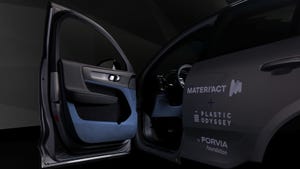August 23, 2008
|
At the K 2007 show, DuPont Engineering Polymers (Wilmington, DE) announced that it will develop and commercialize a nanocrystalline polymer-metal hybrid technology in alliance with three partners: Canada-based Morph Technologies Inc., Integran Technologies Inc., and U.S.-based PowerMetal Technologies. The aim is to manufacture extremely lightweight components with the strength and stiffness of metal that also have the design flexibility and benefits of high-performance thermoplastics.
Keith Smith, VP and general manager for the company, said, “DuPont Engineering Polymers is turning traditional plastic-metal hybrid technology inside-out with an innovative metal-over-plastic technology that not only brings a step-change in performance, but also provides product designers with a technology that can shift their paradigm.”
Called MetaFuse nanometal/polymer hybrids, the patented system involves a proprietary process that applies high-strength nanometal to polymer components. This enables production of lightweight components in myriad, complex shapes with the stiffness of magnesium or aluminum, along with higher strength.
Gino Palumbo, president and CTO of Integran Technologies, said, “MetaFuse produces metals with grain sizes 1000 times smaller than those of conventional metals. Nanocrystalline nickel or nickel-iron are high-performance metals that are two to three times stronger than normal steel and are also significantly harder, with better wear and friction performance.”
Rather than bonding mechanically, MetaFuse directly creates an integral metal cladding with a nanocrystalline grain structure. Nanoparticles are not created at any stage in the manufacturing process.
While metal offers strength and high stiffness, DuPont’s Clive Robertson said that it is limited in its ability to enable integration and to cost-effectively create complex shapes. “Thermoplastic, on the other hand, offers tremendous freedom to create shapes and to integrate functions, but has suffered from some limitation in combining strength and stiffness. With this technology, designers can have the best of both worlds.”
Robertson added that initial developments will focus on selected applications in the automotive, consumer electronics, and sporting goods markets.
You May Also Like



